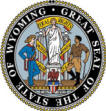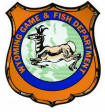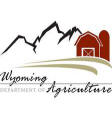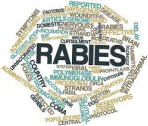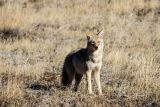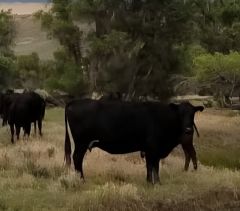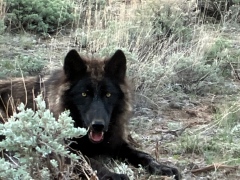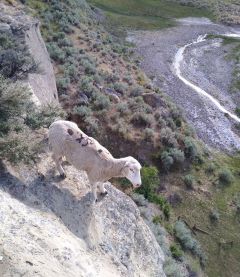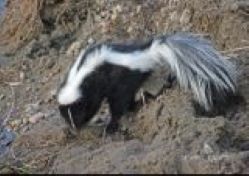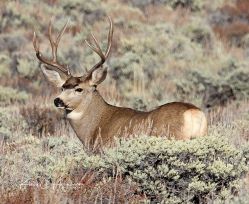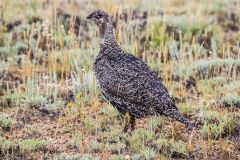|
ARTICLE 3 - WYOMING ANIMAL DAMAGE MANAGEMENT PROGRAM
11-6-301. Short title.
This article may be cited as the "Wyoming animal damage
management program".
11-6-302. Definitions.
(a) As used in this article:
(i)
"Board" means the Wyoming animal damage management board (ADMB);
(ii) "Crop" or "agricultural crop" when not otherwise defined by
statute means corn, oats, wheat, barley, flax, sorghums and
other grains, potatoes, vegetables, forage legumes, hay, and any
other product of cultivation, trees, bees, honey and hives;
(iii) "Damage" means any injury to or loss of livestock,
agricultural crops or wildlife inflicted by predatory animals,
predacious birds or depredating animals;
(iv) "Depredating animal" means any trophy game animal or
furbearing animal that causes damage;
(v) "Furbearing animal" means badger, beaver, bobcat, marten,
mink, muskrat or weasel;
(vi) "Livestock" means horses, mules, cattle, swine, sheep,
goats, poultry, guard animals or any other animal maintained
under domestication. Bison are considered livestock unless
otherwise designated by the Wyoming livestock board and the
Wyoming game and fish commission;
(vii) "Person" means as defined by W.S. 8-1-102(a)(vi);
(viii) "Predacious bird" means any predatory avian species that
is permitted to be taken under either Wyoming law or federal
law;
(ix) "Predatory animal" means:
(A) Coyote, jackrabbit, porcupine, raccoon, red fox, skunk or
stray cat; and
(B) Until the date gray wolves are removed from the list of
experimental nonessential population, endangered species or
threatened species in Wyoming as provided by W.S. 23-1-108,
"predatory animal" includes wolves. After that date, "predatory
animal" shall include any gray wolf within areas of the state
where the state of Wyoming has jurisdiction for wildlife
management, but not within an area of the state in which the
gray wolf is:
(I) Designated as a trophy game animal under W.S.
23-1-101(a)(xii)(B)(I) or (II).
(II) Repealed By Laws 2012, Ch. 25, 2.
(x) "Trophy game animal" means:
(A) Black bear, grizzly bear or mountain lion; and
(B) From and after the date gray wolves are removed from the
list of experimental nonessential population, endangered species
or threatened species in Wyoming as provided by W.S. 23-1-108:
(I) "Trophy game animal" shall include any gray wolf within
those areas where gray wolves are designated as trophy game
animals as provided in W.S. 23-1-101(a)(xii)(B)(I) or (II).
(II) Repealed By Laws 2012, Ch. 25, 2.
(xi) "Wildlife" means all wild mammals, birds, fish, amphibians,
reptiles, crustaceans and mollusks, and wild bison designated by
the Wyoming game and fish commission and the Wyoming livestock
board within this state;
(xii) "Take" means as defined by W.S. 23-1-102(a)(vii).
(b) Repealed By Laws 2012, Ch. 25, 2.
11-6-303. Animal damage management board (ADMB) created;
composition; appointment; terms; vacancies; compensation.
(a) There is created the animal damage management board for the
purposes of mitigating damage caused to livestock, wildlife and
crops by predatory animals, predacious birds and depredating
animals or for the protection of human health and safety. The
board may mitigate damage caused by depredating animals by and
through a memorandum of understanding with the Wyoming game and
fish commission. The board shall be composed of twelve (12)
members appointed by the governor as follows:
(i)
The director of the Wyoming department of agriculture;
(ii) The director of the Wyoming game and fish department;
(iii) One (1) domestic sheep producer;
(iv) One (1) cattle producer;
(v) The state director for the United States department of
agriculture, animal and plant health inspection service,
wildlife services (USDA/APHIS/WS);
(vi) Two (2) members representing the interests of sportsmen,
outfitters and hunters, not more than one (1) of these members
shall be appointed to represent the interests of outfitters;
(vii) The president of the state predator management advisory
board created under W.S. 11-6-201;
(viii) One (1) member from an urban area;
(ix) One (1) member from the Wyoming game and fish commission;
(x) One (1) member of the Wyoming board of agriculture; and
(xi) One (1) member representing the interests of nonconsumptive
users of the state's wildlife resource.
(b) A representative from the United States forest service
(USFS), the United States fish and wildlife service (USFWS) and
United States bureau of land management (BLM) shall serve as
exofficio nonvoting members of the board.
(c) The directors of the departments of agriculture and game and
fish shall serve as co-chairs of the ADMB and shall give general
direction to the ADMB and the ADMB administrative officer.
(d) The director of the department of agriculture or his
designee shall serve as the ADMB's administrative officer and
carry out the ADMB's administrative functions.
(e) Except for the directors of the departments of agriculture
and game and fish, the state director for the United States
department of agriculture, animal and plant health inspection
service, wildlife services (USDA/APHIS/WS), and the president of
the state predator management advisory board created under W.S.
11-6-201, the remaining members of the board shall hold office
for staggered terms of four (4) years. For the remaining members
of the initial board, four (4) members shall be appointed for a
term of four (4) years, four (4) members shall be appointed for
a term of two (2) years. Each appointed member shall be limited
to serving on the board for eight (8) consecutive years,
however, a member may be reappointed after a four (4) year
absence. Each member shall hold office until his successor is
appointed and has been qualified. As terms of current ADMB
members expire, the governor shall appoint each new member or
reappointed member to a four (4) year term.
(f) When a vacancy occurs in the membership for any reason, a
replacement shall be appointed for the unexpired term.
(g) Attendance of six (6) members at a duly called meeting shall
constitute a quorum for the transaction of official business.
The ADMB shall convene at the times and places prescribed by the
chair.
(h) Members of the board who are not government employees shall
receive no compensation or benefits for their services, but may
receive per diem and expenses incurred in the performance of the
member's official duties at the established state rate, to be
paid from the animal damage management account.
(j) Members may decline to receive per diem and expenses for
their service.
(k) State government officer and employee members who do not
receive salary, per diem, or expenses from their agency for
their service may receive per diem and expenses incurred in the
performance of their official duties from the ADMB at the
established state rate, to be paid from the animal damage
management account.
(m) State government official and employee members may decline
to receive per diem and expenses for their service.
11-6-304. ADMB responsibilities; animal damage management
policy; rules; methods to manage predatory animals, predacious
birds, depredating animals and rabid wildlife; manner of calling
meetings; frequency.
(a) The ADMB is responsible for the formulation of the damage
prevention management policy of the state, and by and through an
executed memorandum of understanding (MOU) with the Wyoming game
and fish commission is responsible for management of rabid
wildlife, crop, livestock and wildlife damage done by
depredating animals and wildlife damage by predatory animals and
predacious birds. The ADMB in conjunction with its
responsibility may, consistent with the Wyoming Administrative
Procedure Act adopt rules to implement policies administered by
the ADMB. After consultation with the livestock board and the
department of health, the ADMB shall promulgate rules pertaining
to rabies prevention in wildlife including surveillance, public
education, vaccination protocol, post-exposure procedures and
quarantines. The ADMB may enter into the agreements with law
enforcing agencies to carry out the quarantine provisions.
Nothing in this article shall preempt the Wyoming game and fish
commission authority to manage wildlife or determine damage
pursuant to any provision in title 23.
(b) In its deliberations the ADMB shall:
(i)
Entertain requests for assistance in order to allow mitigation
of predator damage;
(ii) Specify programs designed to prevent damage by predatory
animals, rabid wildlife, predacious birds and depredating
animals to livestock, agricultural crops, wildlife, property,
human health and safety;
(iii) Provide various degrees of predatory animal, predacious
bird and depredating animal damage management services to
individual agricultural livestock and crop producers,
landowners, lessors or administrators, and to urban, residential
and industrial property owners. Damage management services shall
also be provided and conducted for the benefit of wildlife
populations and human health and safety;
(iv) Specify methods for the prevention and management of damage
and for the selective control of predatory animals, rabid
wildlife, predacious birds and depredating animals;
(v) Maintain responsibility and appropriate funds for the
purpose of providing damage prevention and management to
agricultural livestock and crops, wildlife, property and human
health and safety caused by predatory animals, rabid wildlife,
predacious birds and depredating animals;
(vi) Cooperate with federal, state and county governments,
educational institutions and private persons or organizations to
effectuate agricultural and wildlife damage and rabid wildlife
prevention policies;
(vii) Develop memorandums of understanding between the Wyoming
department of agriculture and the Wyoming game and fish
commission and the United States department of agriculture,
animal and plant health inspection service, wildlife services
(USDA/APHIS/WS) to accommodate funding sources and
administrative guidelines for the program;
(viii) Consider any recommendations received from the Wyoming
game and fish commission and the Wyoming department of
agriculture.
(c) The ADMB shall conduct meetings in accordance with its
established policy, but shall meet at least once each year in
the month of January.
(d) The ADMB may adopt rules and regulations necessary for
carrying out the purpose and provisions of this article. The
ADMB may appoint employees and assistants as necessary and fix
their compensation. The ADMB may enter into cooperative
agreements with boards of county commissioners, predator
management districts, federal or state agencies or other
commissions, organizations or associations for the purpose of
managing predatory animals, rabid wildlife, predacious birds and
depredating animals. Predator management district boards which
choose not to enter into a cooperative agreement with the ADMB
shall not be precluded from continuing with, or entering into, a
cooperative agreement or memorandum of understanding with the
United States department of agriculture, animal and plant health
inspection service, wildlife services (USDA/APHIS/WS), other
entities of government, organizations or associations. This act
is not intended and shall not replace, rescind, modify nor
cancel cooperative agreements or cooperative service agreements
between the USDA/APHIS/WS and the county predator management
districts created under W.S. 11-6-201 through 11-6-210.
(e) The ADMB may elect to provide various degrees of predator
damage management services to any other person pursuant to a
separately negotiated cooperative agreement.
(f) The board shall investigate, test and refine the concept and
practices of integrated predator management. The board shall
develop and establish measurable goals and objectives. The board
shall report to the governor and the joint agriculture, public
lands and water resources interim committee and joint
appropriations interim committee on or before November 30 of
each year to determine the progress the board has made toward
achieving the goals and objectives it has established. The
report shall also include actions taken, the accomplishments and
state monies expended by each county predator management board
participating in state funding.
11-6-305. Wyoming animal damage management board funding;
sources; methods of collection.
(a) Repealed by Laws 2020,
ch. 48, § 2.
(b) Repealed by Laws 2020,
ch. 48,
(c) The ADMB may receive money for predatory animal, predacious
bird and depredating animal management from the federal
government, state appropriations, counties, agencies, boards,
associations, commissions, individuals and any other
cooperators, and may expend monies to purchase supplies,
materials, services, and to employ or contract personnel for
predatory animal, predacious bird and depredating animal damage
management. The ADMB may make supplies, materials, services and
personnel available to cooperators at approximate cost.
11-6-306. Animal damage management account.
(a) There is created the animal damage management account.
(b) Money received under W.S. 11-6-305 shall be deposited by the
state treasurer in the animal damage management account to be
appropriated for the purposes provided in this article.
(c) Any supplemental contributions received by the department
from livestock owners for predatory animal, predacious bird or
depredating animal damage management programs or the prevention
and management of rabid wildlife shall be deposited into the
animal damage management account.
(d) The animal damage management account shall be administered
for the ADMB by the Wyoming department of agriculture.
11-6-307. Board to request funding from game and fish
commission.
The board shall annually request two hundred thousand dollars
($200,000.00) from the Wyoming game and fish commission. These
funds shall be expended for wildlife priorities. The game and
fish commission may provide recommendations to the board
regarding expenditure of these fund. Priority shall be given to
projects that directly involve predator control that will have
the greatest benefit to wildlife or will reduce the cost to the
department for animal damage payments.
11-6-308. District boards; relation to ADMB; duties generally.
(a) Each predator management district board shall:
(i)
Exercise general supervision in determining local priorities for
the management of predatory animals and predacious birds that
prey upon and destroy livestock, other domestic animals,
wildlife and crops;
(ii) Devise and put in operation those methods that best manage
predatory animals and predacious birds;
(iii) Administer funds received to carry out the animal damage
management program;
(iv) Maintain existing financial and physical resources;
(v) Provide input to the ADMB.
11-6-309. Predator management district participation with the
ADMB.
(a) Except as provided in
subsection (b) of this section, if the predator management
district has elected to participate in providing funding or upon
approval of the ADMB, other in-kind resources, to the animal
damage management account, the district may solicit funds or
receive services from the ADMB under separate negotiated
agreement. Two (2) or more districts may jointly solicit funds
or receive services from the ADMB for purposes of this section.
(b) Whether or not a predator management district has elected to
participate in providing funding to the animal damage management
account, the district may solicit funds or receive services from
the ADMB for control of gray wolves designated as predatory
animals.
(c) In any area of the state not under the jurisdiction of a
county predatory animal board, eligible applicants for funds
appropriated to the animal damage management board for the
purpose of controlling wolves designated as predatory animals
include state or county agencies.
11-6-310. Applicability of chapter.
This article, unless contrary to federal law, shall apply to all
federal, state and private lands.
11-6-311. Exemptions.
The state predator management advisory board or the ADMB may
exempt persons from payment of the imposed fees when the
respective board determines that livestock as defined in this
act are permanently confined within pens or corrals within
incorporated city limits where animal damage control activity by
state or federal agencies is prohibited or severely restricted.
11-6-312. Cooperative agreements generally.
The ADMB may enter into cooperative agreements with other
governmental agencies, counties, associations, corporations or
individuals for carrying out the purposes of this article.
11-6-313. Repealed By Laws 2008, Ch. 39, 1.
Wyoming
Animal Damage Management Board
Chapter
1
Regulations Governing the Granting of
Predator Management Program Funds
Section
1. Authority.
Pursuant to authority vested in the Wyoming Animal Damage
Management Board (ADMB) in W.S. § 11-6-304(d) the following
regulations are hereby promulgated and adopted.
Section 2. Purpose of
rules. These rules govern the distribution of funding
appropriated by the Wyoming state legislature through the ADMB
to the county Predator Management Districts (PMD) created by
W.S. § 11-6-201.
Section 3. Definitions.
For the purpose of this regulation, definitions shall be as set
forth in Title 11, Wyoming Statutes and the board also adopts
the following definitions:
(a)
“Animal Damage Management Board or ADMB” means the statutorily
created board under W.S. § 11-6-303.
(b)
“Annual Report” means the final documentation the district must
provide at the end of the state fiscal year (June 30).
(c)
“Assess” means to fix or determine the amount and to impose a
tax or other charge on.
(d)
“Audit” means the unbiased examination and evaluation of the
records, financial accounts, and financial statements of the
district to verify their accuracy. The audit shall be performed
in compliance with the State of Wyoming - Department of Audit,
W.S. § 9-1-507(a)(iii) and Dept. of Audit Chapter 6 rules for
special districts.
(e)
“Budget” means an itemized summary of estimated or intended
income and expenditures for a given period. For the purposes of
this rule, the budget shall be compiled for the state fiscal
year of July 1 – June 30.
(f)
“Capital Equipment” means tangible equipment purchased for long
term use by the district. For the purposes of these rules,
capital equipment is a single piece of equipment and necessary
attachments with a cost of more than $1,000.00 (one thousand
dollars).
(g)
“Collect” means to receive or compel payment of.
(h)
“Commercial Feedlot" means any place, establishment or facility
commonly known as a feedlot conducted, operated or managed for
profit or nonprofit for livestock producers, feeders or market
agencies, consisting of pens and their appurtenances, in which
livestock are received, held, fed, cared for or kept for sale or
shipment in commerce.
(i)
“District” means a predator management district created under
W.S. § 11-6-201(a).
(j)
“District Board” means the board of directors of a district
created under W.S. § 11-6-202.
(k)
“Encumbered Funds” means those funds which have been obligated
for use by contract or invoice.
(l)
“Financial Statement” means a compilation of a district’s
financial status. Such records shall include a balance sheet
(statement of financial position), an income statement (income
and expenditure statement), a cash flow statement, and
supplementary notes and recorded significant financial
management decisions.
(m) “Grant
Application ” means the form and documents with which a request
is made for funding. The form will be prescribed and distributed
by the ADMB.
(n)
“Management Plan” means a proposed or tentative course of
action, including programs or policies stipulating the proposed
service and expected benefits.
(o)
“Predacious Bird” means any predatory avian species that is
permitted to be taken under either Wyoming law or federal law.
(p)
“Predatory Animal” means coyote, jackrabbit, porcupine, raccoon,
red fox, skunk or stray cat; and gray wolf as allowed by law.
(q)
“Standard Budget” means an annual or biennial request for
funding from a district that provides for a base level of
funding for general operational needs of the district.
Section 4. Applicability of rules.
These
rules shall only apply to districts that solicit or receive
grant funding from the ADMB under the program as outlined in
these rules.
(a)
No state funds awarded to a district by the ADMB shall be used
to satisfy debt existing prior to the effective date of these
rules.
Section 5. Qualifications for
funding.
To qualify for funding under these rules, the district shall:
(a) Submit
the following to the ADMB:
(i)
Proof of compliance with W.S. § 11-6-202(a)(v).
(ii)
Completed grant application on a form prescribed by the ADMB
(iii)
Budget
(iv)
Management Plan
(v)
Financial Statement
(vi) Proof
of having assessed and collected all available funds as required
by W.S. § 11-6-210(o)
(A)
Each district, in accordance with W.S. § 11-6-210(f) shall
determine which facilities meet the definition of a commercial
feedlot.
(B)
Each district shall establish a method by which assessment,
billing and collection for goats may be conducted.
(vii)
Report stating the accomplishments or actions relative to the
prior year’s management plan. The requirement shall only pertain
to districts that have previously received state funds under
these rules.
(b) In
addition, the district shall assure that:
(i)
It is in compliance with applicable Wyoming statutes; and
(ii) All
agreements with the ADMB are current or satisfied.
Section 6. Funding Distribution.
Funding shall be applied for and justified through the grant
application process as follows:
An initial
standard budget of $50,000.00 shall be awarded by the ADMB to
each qualified district whose application has been approved by
the ADMB prior to May1, 2007.
The
application must be received by the ADMB prior to April 1, 2007.
Thereafter, the ADMB shall annually establish a standard budget
amount that shall be provided to all qualified districts with an
application submitted prior to April 1.
(i)
Additional funds, including but not limited to operational
expenses and capital purchases, may be applied for by the grant
application and justified in the management plan and budget.
A maximum
of ten percent (10%) of the standard budget may be used to
purchase capital equipment.
(i)
Additional funds, including but not limited to operational
expenses and capital purchases, may be applied for by the grant
application and justified in the management plan and budget.
Section 7. Grant Applications.
The grant application form shall be developed by the ADMB in
accordance with the requirements of this regulation. The ADMB
shall make a grant application form available to all districts.
(a) A
district requesting grant funds shall submit a new grant
application, budget and management plan no later than the date
specified on the initial grant application and not later than
April 1 of future years.
Section 8. Financial Records.
The district shall provide a budget with the grant application.
A standardized form will be provided by ADMB.
The budget
shall show all proposed income and expenses of the district.
The budget
shall be accompanied by the district’s current financial
statement.
(c) Audit
Reports as required by W.S. § 9-1-507(a)(iii) and Chapter 6
rules for special districts shall be submitted to the State
Department of Audit and a copy to the ADMB.
Section 9. Management
Plan. The district shall include a management plan with the
grant application. The management plan shall provide details of
the proposed action and the expected results.
The
management plan shall address the following, as applicable for
the district or funding requested:
Wildlife
issues and goals
Livestock
issues and goals
Pre- and
post-work monitoring
Partnerships and cooperative agreements required to accomplish
the management plan.
The
criteria shall include but not be limited to the cost of
full-time and part-time trappers and the cost of fixed wing
aircraft and helicopters, for predator management for livestock
and wildlife.
Human
health and safety issues.
Section 10. Reporting.
The district shall submit an annual report, due to the ADMB,
2219 Carey Avenue, Cheyenne, WY 82002 by no later than July 1st
of each year. This report should be relative to the current
fiscal year.
The annual
report shall contain the following:
Actions
taken.
Identifiable and measurable results.
Grant
monies expended.
Current
financial statement.
Most
recent audit report .
Supplemental reports may be requested by the ADMB on any
identified and targeted management or site specific projects, at
the time funding is provided to the district to carry out such
projects.
Section 11. Loss of eligibility.
Any district that does not comply with all provisions of these
rules shall not be eligible for additional grant funding until
they have documented correction of all compliance deficiencies
to the satisfaction of the ADMB. Districts that demonstrate
correction of all deficiencies may submit a grant application
for funding consideration for the next fiscal year.
Section 12. Authority to determine
funding amounts.
In all
cases, the ADMB retains the authority to allocate funding to
qualified districts in the amount determined by the ADMB to
carry out the intent of W.S. § 11-6-201.
Section 13. Savings Clause.
If any provision of this regulation is held to be illegal or
unconstitutional, such a ruling shall not affect the other
provisions of this regulation which can be given effect without
the illegal or unconstitutional provision; and, to this end, the
provisions of this regulation are severable.
Wyoming
Animal Damage Management Board
Chapter
2
Regulations Governing the Granting of
Wolf
Management Program Funds
Section
1. Authority.
Pursuant to authority vested in the
Animal Damage Management Board by W.S. § 11-6-304, the following
regulations are hereby promulgated and adopted.
Section 2. Regulation.
The Wyoming Animal Damage Management Board
(ADMB) adopts
the following regulation governing
the distribution of funding appropriated by the Wyoming state
legislature for emergency wolf management for the control of
gray wolves in Wyoming where designated as a predatory animal.
The gray wolf is designated as a
predatory animal as defined in W.S. §11-6-302(a)(ix)(B) and W.S.
§23-1-101(a)(viii)(B) except in:
(a) Those areas where gray wolves
are designated as trophy game animals by W.S. §23-1-101
(a)(xii)(B)(I) and (II), and
(b) Yellowstone National Park; and,
(c) The Wind River Reservation,
except on non-Indian owned fee titled lands.
Section 3. Definitions.
For the purpose of this regulation, the definitions set forth in
Title 11 of the Wyoming Statutes apply unless the context or
subject matter clearly requires a different interpretation.
The following definitions are
adopted:
(a) “District” means a predator
management district created under W.S. § 11-6-201(a).
(b) “District Board” means the
board of directors of a district created under W.S. § 11-6-202
(c) “USDA/APHIS/Wildlife Services
or WS” means the federal agency that provides predator
management in Wyoming.
(d) “WDA” means the Wyoming
Department of Agriculture
(e) "Director" means the Director
of the Department of Agriculture for the state of Wyoming or his
designated representative
(f) “Qualified agent or agent”
means an individual, company, or organization that can provide
necessary service and equipment for managing gray wolves.
Section 4. Applicability
of Rules.
These rules shall apply to all
Districts in Wyoming, whether or not they solicit or receive
grant funding from the WDA under any other program.
These rules do not preclude any
District from performing wolf management work, using its
existing personnel at the district’s expense.
Section 5.
Qualifications for Funding.
To qualify for funding under these
rules,
(a) A livestock owner, whose
livestock has been injured or killed in an area in Wyoming where
the gray wolf is designated as a predatory animal, and who
suspects the injury or kill is from a gray wolf must:
(i) Contact USDA/APHIS/Wildlife
Services (WS), or another qualified agent approved by the
Director, to verify that the livestock loss or injury was due to
wolf depredation; and
(ii) If the livestock loss or
injury is due to wolf depredation, contact the WDA Predator
Management Coordinator to request assistance in managing the
depredating wolf problem.
(b) The WDA Predator Management
Coordinator will then contact WS, or another qualified agent
approved by the Director, for assistance in managing the
depredating wolf problem.
The WDA Predator Management
Coordinator will also contact the Predator Management District
President or Vice President to notify them of wolf activity in
their district.
(c) Through an established
Memorandum of Understanding (agreement) between the ADMB and WS,
or contract between the ADMB and another qualified agent
approved by the Director, WS or the agent will assist the
livestock owner, for a reasonable amount of time as agreed upon
between WS, or the agent and the livestock owner at the time
when WS, or the agent’s, assistance is requested.
WS or the agent will provide an
invoice to the WDA for the services provided to the livestock
owner.
(d) Assistance in wolf management
may be requested for human health and safety issues and the
Director may grant funding for such assistance at his
discretion.
Section 6. Funding
Distribution.
An invoice from WS or agent
providing wolf management assistance shall be submitted to the
WDA to request wolf management funds.
(a) Initial funding shall be
available for payments for wolf management.
Any balance left over after the
first year shall roll forward into the second year.
(b) Thereafter, the WDA may
annually establish a budget amount that shall be provided to
reimburse, WS or approved agents of wolf management service.
Section 7. Authority to
Determine Funding Amounts.
In all cases, the WDA retains the
authority to allocate funding to providers of wolf management
assistance in the amount determined by the WDA.
Section 8. Savings
Clause.
If any provision of this regulation
shall be held to be illegal or unconstitutional, such a ruling
shall not affect other provisions of this regulation which can
be given effect without that provision; and, to this end, the
provisions of this regulation shall be severable.
Wyoming
Animal Damage Management Board
Chapter 65
Gray Wolf Depredation Compensation
Program Regulations
Section
1.
Authority.
Pursuant to the 2023 Session
Laws, Chapter 98, the following regulations are promulgated.
Section
2.
Definitions.
(a)
“Claim
form” means
the Department’s
Gray
Wolf
Animal Damage
Claim
Affidavit.
(b)
“Claimant”
means
any
landowner,
lessee,
or
agent
who submits an application for compensation for
livestock
that has been damaged
or killed by
a gray
wolf.
(c)
“Consequential
damages”
means damage,
loss, or injury
that does
not flow directly
and immediately
from the
act of the
gray
wolf, but only
from
some of
the consequences
or
results
of such act, including
future or
anticipated
production,
sentimental
value, and labor
or equipment
costs to
remove damaged
property.
(d)
“Damage” means any injury or loss to livestock inflicted by
a gray wolf in an area of the state where gray wolves are
classified as predatory animals.
(e)
“Department”
means the
Wyoming
Department
of Agriculture.
(f)
“Gray wolf” means the
gray wolf where it is
designated as a predatory animal as set forth in W.S.
11-6-302(a)(ix)(B).
(g)
“Livestock” has the meaning set forth in W.S.
23-1-102(a)(xvi).
(h)
“More likely than
not” means evidence reasonably tending to support the
conclusion. Evidence that is competent, relevant, material and
which to a rational and impartial mind naturally leads, or
involuntarily leads to conclusion for which there is valid,
just, and reasonable substantiation.
(i)
“WS”
means the
United States Department of Agriculture, Animal and
Plant
Health
Inspection
Service,
Wildlife
Services.
Section 3.
Qualifications
for
Consideration.
To be eligible for potential compensation, a claimant must
notify the Department by phone that damage to livestock has
occurred and suspect that it was caused by gray wolves.
Following this notification, the Department will dispatch an
investigator from WS or the Wyoming Game and Fish Department to
determine whether the damage was more likely than not caused by
gray wolves. If the damage was more likely than not caused by
gray wolves, the claimant must report the damage to the
Department by submitting a
depredation
investigative
report
completed by the WS or Wyoming Game and Fish Department
investigator as soon as
possible but no later than 15 days after discovery of the
damage. The
Department shall
only consider
complete
applications
submitted no later
than 60
consecutive
days
after
the
damage
ended
or the last
damage
was discovered. A complete
application
consists of the following documents:
(a)
A completed
claim
form;
(b)
A copy
of the
depredation
investigative
report
from the WS or Wyoming Game and Fish Department investigator for
each
gray
wolf
depredation
incident
that confirms
that the livestock
damage was
more likely than not caused by a gray wolf;
(c)
The documents supporting the
value
determination
of the damage, such as:
(i)
The fair market value for like livestock at a rate substantiated
by a livestock sale barn on the date of damage; or
(ii)
For young of the year livestock, the fair market value for like
livestock at the weaning weight substantiated by a livestock
sale barn; or
(iii)
Other credible written valuation of the livestock; and
(d)
Any additional supporting
documents the claimant may wish to submit.
Section 4.
Available
Funding
and
Distribution.
(a)
The Department will allocate
available funds into five time periods. The first time period is
from
July 1, 2023, through
June 30, 2024. The second time period is from July 1, 2024,
through June 30, 2025. The third time period is from July 1,
2025, through June 30, 2026. The fourth time period is from July
1, 2026, through June 30, 2027. The fifth time period is from
July 1, 2027, through June 30, 2028. The
Department shall
receive
applications during those five time
periods.
Budget reductions may reduce or eliminate available funds for
one or all time periods.
(b)
If
the Department
employs
or
contracts
personnel
to assist in
administering
and investigating
claims
for
damages,
the costs
for personnel
fees shall
be deducted
from
the total funds
available
prior to paying any
compensation to claimants.
(c)
Within
ten
days after
the end of
each time
period established by this Section, the Department shall
review
each
application
and determine
if the application
is complete
and
accurate.
If
the Department determines that the
application is
complete and accurate,
it is a verified
claim
and
eligible
for
compensation. If the Department determines that an
application is complete but partially inaccurate, he may either
verify the accurate portion and strike the inaccurate portion of
the application or deny the application.
Within 90
days
after
the end
of
each period, the Department shall total
all verified
claims
and process
them for
payment
subject to availability of funds.
(d)
If the total verified claims and personnel fees in the
first period are less than or equal to the amount of funds
available for that period, then the
Department shall pay all
verified claims in full. Any leftover funds shall rollover and
be available for distribution in the next period. If the total
verified claims and personnel fees in any period exceed the
amount available for that period, then the Department officer shall first deduct the personnel fees and then prorate payments
of the remaining funds according to the total number of verified
claims received in that period.
Section 5.
Denial
of Claims.
The Department shall deny
all or
any part
of a
claim
if:
(a)
The application contains materially false or inaccurate
information.
(b)
The incident on which the
application is based occurred on property
where
a
gray
wolf
is not defined as a predatory
animal as set forth in
W.S. 11-6-302(a)(ix)(B).
(c)
The claimant
did not present
a completed
application with all
required
information
to the
Department within 60
days
after
the damage
or last
item of
damage
was
discovered
by
the claimant.
(d)
The claim
was
for
consequential
damages.
(e)
The dollar amount claimed exceeds the value of the livestock
that were damaged.
The claimant submitted a claim for compensation for the
same damaged livestock to the Wyoming Game and Fish Department.
|
